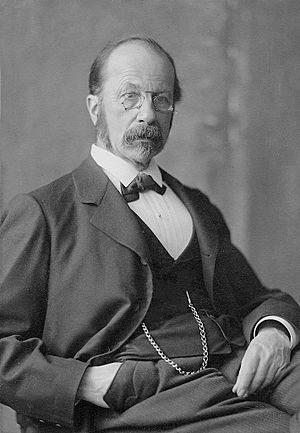Wilhelm His Sr. facts for kids
Quick facts for kids
Wilhelm His Sr.
|
|
|---|---|

c. 1900
|
|
| Born | 9 July 1831 |
| Died | 1 May 1904 (aged 72) |
| Nationality | Swiss |
| Known for | Microtome, contribution to neuron doctrine |
Wilhelm His Sr. (born July 9, 1831 – died May 1, 1904) was a smart Swiss scientist. He was an anatomist, which means he studied the structure of living things. He is famous for inventing a special tool called the microtome. This tool helps scientists cut very thin slices of animal tissue. By doing this, they could study tiny cells and tissues much better under a microscope.
Contents
Studying the Body: Wilhelm His's Career
Wilhelm His came from a well-known family. He studied medicine in many cities like Basel, Berlin, and Vienna. He earned his first doctorate degree in 1854. A few years later, in 1856, he got a higher doctorate in Basel.
In 1857, when he was just 26, he became a professor. He taught about the body's structure (anatomy) and how it works (physiology) at the University of Basel. Later, in 1872, he moved to the University of Leipzig to become a professor there.
Discovering Endothelium
Wilhelm His helped us understand a type of tissue called endothelium. These are special inner linings found inside the body, like in blood vessels. Before him, scientists grouped them with other tissues. His showed how they were different and how they developed in a growing body.
How Our Bodies Form
His also studied how our bodies develop. He believed that traits we get during our lives, like strong muscles from exercise, cannot be passed on to our children. This idea was important because other scientists at the time thought differently. He wrote about this in his 1874 book, The Form of Our Body and the Physiological Problem of Its Development.
Studying Embryos
Wilhelm His made big discoveries about how the nervous system grows. Between 1879 and 1886, he studied 12 human embryos. These embryos were from 2 to 8.5 weeks old. He watched how nerves grew into different parts, like into the fingers. This helped us understand how our brains and nerves develop.
In 1892, he was chosen to be a member of the Royal Swedish Academy of Sciences. This is a very important group of scientists.
Reconstructing Faces: Bach's Skull
Wilhelm His also used his knowledge of anatomy to do something very unique. In 1895, he recreated the face of the famous composer Johann Sebastian Bach. He did this using Bach's skull.
Measuring Facial Tissues
To do this, His first measured how thick the tissues are on people's faces. He used a thin needle with a small rubber piece. He pushed the needle into the tissue of bodies that had been donated for science. The rubber piece would slide up the needle until the needle touched the bone. He then measured how far the rubber piece moved. This told him the exact depth of the tissue at that spot.
He took these measurements at 15 specific spots on many different bodies. This detailed information helped him figure out how to rebuild a face from a skull. His work was a big step in forensic facial reconstruction, which is used today to identify people from their remains.
Wilhelm His Sr. was also the father of another famous scientist, Wilhelm His Jr., who was a doctor and heart specialist.
See also
 In Spanish: Wilhelm His para niños
In Spanish: Wilhelm His para niños
- Wilhelm His Jr.
- Embryology
- Forensic facial reconstruction

